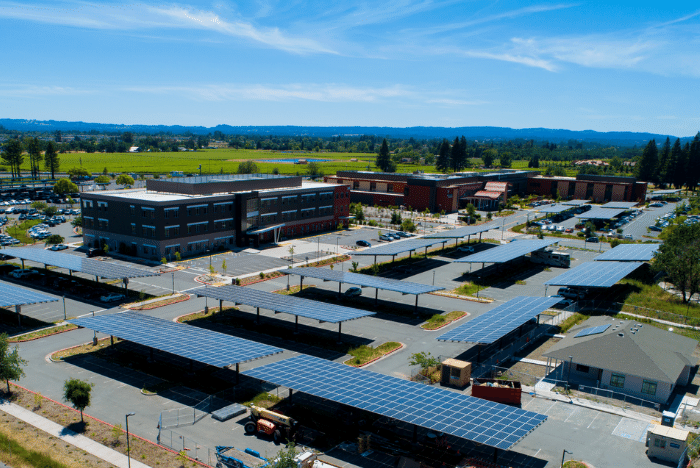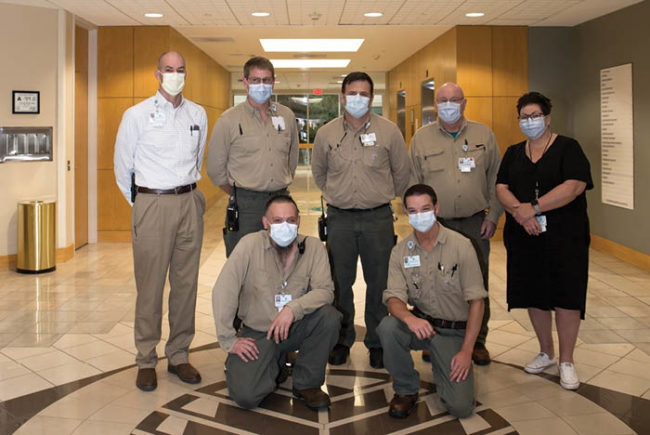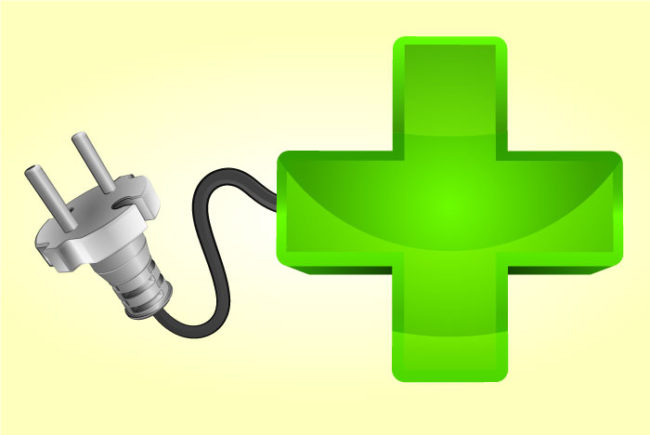
Courtesy of Ameresco, Inc.
The health care industry is being called upon to reduce greenhouse gas emissions and build more climate-resistant infrastructure through the U.S. Office of Climate Change and Health Equity’s (OCCHE) Health Care Sector Pledge. As a result, health care facilities are being asked to incorporate clean energy solutions, such as distributed generation, to make good on this commitment. With this comes key considerations exclusive to the industry, requiring due diligence from facility managers and hospital leadership when formulating a decarbonization plan. While there are numerous stakeholders to consider, none are as important as the facility’s patients. Any infrastructure and energy project needs to be tailored to mitigate potential impacts on patient care. So, where does one start, and what are the key considerations?
Understanding how and when a facility uses energy can inform the first steps to take; after all, you cannot reduce what you cannot measure. Ameresco’s proprietary enterprise asset management platform provides customers with the capability to organize their risk management criteria associated with their infrastructure and to identify the most important renewal and replacement projects. The platform includes a carbon inventory tool, which is used to help many customers measure their carbon footprint in support of their net-zero commitments.
Considerations for solar generation at health care facilities
According to the Department of Energy, hospitals are currently the second most energy-intensive building type in the United States, and the Department of Health and Human Services reported this year that the health care sector contributes 8.5% of total U.S. emissions. To support renewable energy development while mitigating the high costs and environmental impacts from the industry’s energy usage, the federal government has created incentive programs such as the Investment Tax Credit (ITC), known as the solar tax credit.
While implementing solar energy has numerous benefits, the development plan may require some consideration. Partnering with a renewable-energy solutions provider that has experience working in different regions and is well versed in state-specific codes and requirements contributes to making the transition to clean energy a smoother one. Implementing on-site solar can pose challenges if a facility has limited space or specific coding requirements. Ground-mounted solar and solar parking canopies may be more feasible options, as they also offer value-add amenities such as covered parking spaces from sun or snow and self-powered electric vehicle charging opportunities.
Ameresco partnered with Sutter Health Santa Rosa Regional Hospital in California on a carport solar project across the campus and, given restrictions on rooftop solar, installed a roof-mounted solar array on a private four-room residence for families of children hospitalized at Santa Rosa Regional called Shea House. Not only does the on-site energy generation system power 40% of the hospital’s electricity and 89% of the electricity used at the Shea House, but the solution also fits into the surrounding natural environment. This is one of many Sutter sites that Ameresco is working on as part of a long-term partnership with the hospital network, finding ways to add value and resiliency such as battery energy storage.
For enterprise organizations, an energy partner with a national footprint can help guide a client through choosing the optimal deployment for on-site generation. Companies like Ameresco have worked with customers across North America and Europe to implement a variety of solar energy systems, each with unique regional stipulations, differing climates and terrains. Ameresco’s strategic process promotes consistency in design and communication, quality and focused support by bringing skilled engineers, project managers and construction managers to each account. The company regularly works with leaders on a state and local level to build relationships within the community and foster stakeholder support. Additionally, Ameresco’s teams are members of health care industry organizations and associations, equipping them to stay on top of state-specific codes required by the industry and help customers navigate through this aspect of solar energy development.
Identifying additional opportunities for cost savings and resiliency
Solar can reduce energy costs, carbon footprint and reliance on the grid; however, a facility may benefit from additional distributed resources. For example, microgrids and battery storage ensure resiliency, alternative thermal heating or renewable natural gas (RNG) replaces natural gas consumption, and building automation systems maintain and improve comfort and safety while detecting issues related to building performance. And, with a 6.4% increase in the turnover rate across all jobs in the health care industry in 2021 according to the Bureau of Labor Statistics, it is also important to incorporate training into an energy management project to reduce impacts from personnel changes and maintain accurate reporting and maintenance.
Ameresco’s work with Naples Community Hospital (NCH) Healthcare System, located in Florida with two facilities encompassing more than 840,000 square feet, helped the hospital determine the Energy Utilization Index (EUI) to identify where the most energy was being consumed while addressing a need to control humidity levels. Through an investment-grade energy audit, Ameresco developed an energy master plan that prioritized and scheduled improvements alongside the facilities master plan that could be completed throughout a five-year general plan. The implemented energy conservation measures at both campuses included LED lighting and boiler plant upgrades, as well as chiller and cooling tower replacements in addition to retro commissioning at the downtown campus.
From “if” to “when” — funding solutions to get projects started
Between the lingering expenses from the COVID-19 pandemic and unavoidable, rising energy costs that are needed to meet patients’ needs, the health care industry benefits from innovative solutions to finance renewable energy projects. More holistic project models like energy as a service (EaaS) defer energy- and infrastructure-related risk to a trusted partner and do not require capital outlay to address decarbonization targets and deferred maintenance requirements. Under an EaaS agreement, the energy partner can own the equipment or resources being installed, and the customer may opt for off-balance sheet treatment. This can be attractive to organizations depending on preferences around risk and responsibility.
Under a power purchase agreement (PPA), health care facilities can offload renewable energy development costs, lower overall utility costs and generate working capital. By entering into a contract with a power supplier, organizations can monetize underutilized land parcels, roofs and parking lots. The PPA provides a stable cost for renewable electricity and can also deliver a reliable source of revenue for the length of the contract. Federal tax credits coupled with a solar PPA can make the resulting power competitively priced on the open market. And, as many hospitals are nonprofit entities, both the PPA and EaaS financing structures allow the owner to use the ITC toward the cost of the energy system.
An energy savings performance contract (ESPC) allows customers to renew facilities and reduce energy costs by financing through future energy savings. The Veterans Integrated Service Network Region 6 (VISN 6) selected Ameresco to perform energy efficiency upgrades to improve their infrastructure under the Department of Defense ESPC program for Veterans Administration medical centers. Working in coordination with facility operations, Ameresco designed, built, measured, verified and supplied training for upgrades across 60 buildings within a three-state region, enabling the hospitals to focus on its mission and passion to provide safe, efficient, effective and compassionate care to the patients they so proudly serve.
A common goal for good
The implementation phase of distributed resources — such as solar photovoltaic and battery energy storage — at health care facilities requires a project development strategy centered on making patient care a top priority. From an experienced engineering and construction team trained to adhere to HIPAA requirements to implementing creative solutions and being able to work effectively on-site while minimizing downtime, finding a partner who is well versed in the health care environment pays dividends.
Ameresco’s recently published white paper “Destination: Net Zero — Six Steps to Address Climate Protection Goals for the Decisive Decade” includes a step-by-step process simplifying the decarbonization journey while addressing many of the challenges inherent to developing net-zero programs. Whether implementing energy conservation measures, installing solar or other distributed generation resources, or integrating resilient energy solutions, choosing an experienced partner who understands the incentives for — and the requirements of — a health care facility and its occupants is crucial.
Health care providers and renewable energy professionals have a shared passion for creating a healthier world. Between improving patient care and recognizing how climate change is impacting human health, the medical community has an inherent interest in a clean energy transformation beyond external stakeholder pressures.
An experienced energy partner who stays informed of industry requirements and developments is what differentiates the level of service and results of a renewable energy project. Additionally, the trust and care patients and families expect from the health care community is comparable to the attention to service required from an energy partner. A winning combination is an energy partner who works alongside customers to serve their needs through all phases of work. Together, they develop solutions to prioritize the comfort of patients, staff and visitors while strengthening the long-term resiliency of their energy infrastructure.





